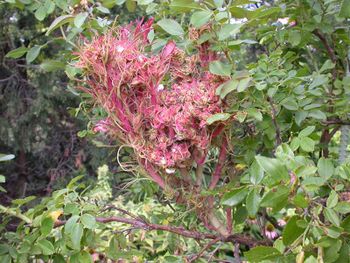Rose Rosette Virus
Rose Rosette Virus
By Jacob Scharfetter

Rose Rosette Virus (RRV) was first described in the 1940s and has since become one of the most destructive diseases of Rosa spp. (Conners, 1941[1]). The disease is characterized by excessive thorniness, over zealous leaf proliferation, leaf mosaic patterning, red pigmentation, and witches' broom (see image). As there is no cure for RRV most infected plants will eventually die. Typically, a mature rose plant succumbs to disease after a period of three years. However, there is great amount of variability in Rosa spp. susceptibility, e.g. Rosa multiflora is highly susceptible to the disease while Rosa setigera is believed to be resistant to RRV [2]. Rose rosette virus is widespread across the United States stretching from the eastern seaboard to the foothills of Rocky Mountains (Laney et at., 2011[3])
Sample citations: [4]
[5]
A citation code consists of a hyperlinked reference within "ref" begin and end codes.
Section 1
Include some current research, with at least one figure showing data.
Every point of information REQUIRES CITATION using the citation tool shown above.
Section 2
Include some current research, with at least one figure showing data.
Section 3
Include some current research, with at least one figure showing data.
Section 4
Conclusion
References
- ↑ Conners, I.L. Twentieth Annual Report of the Canadian Plant Disease Survey 1940; Department of Agriculture: Ottawa, Canada, 1941; p. 98.
- ↑ Missouri Botanical Garden: Rose Rosette
- ↑ http://jgv.microbiologyresearch.org/content/journal/jgv/10.1099/vir.0.031146-0#tab4/ Laney A., Keller K., Martin R.,& Tzanetakis I. A discovery 70 years in the making: characterization of the Rose rosette virus. 01 July 2011, Journal of General Virology 92: 1727-, doi: 10.1099/vir.0.031146-0]
- ↑ Hodgkin, J. and Partridge, F.A. "Caenorhabditis elegans meets microsporidia: the nematode killers from Paris." 2008. PLoS Biology 6:2634-2637.
- ↑ Bartlett et al.: Oncolytic viruses as therapeutic cancer vaccines. Molecular Cancer 2013 12:103.
Authored for BIOL 238 Microbiology, taught by Joan Slonczewski, 2017, Kenyon College.
